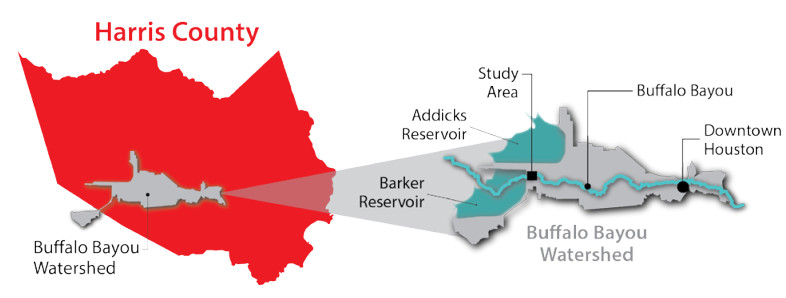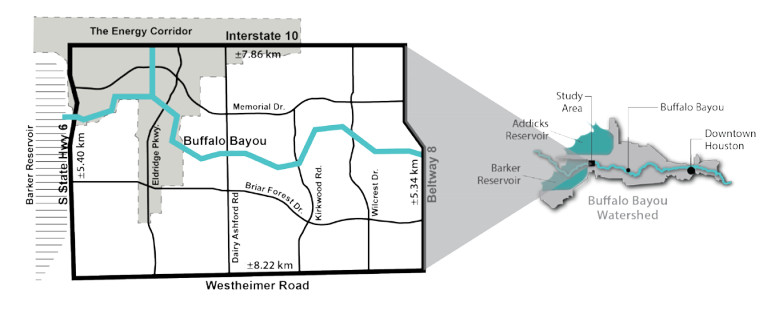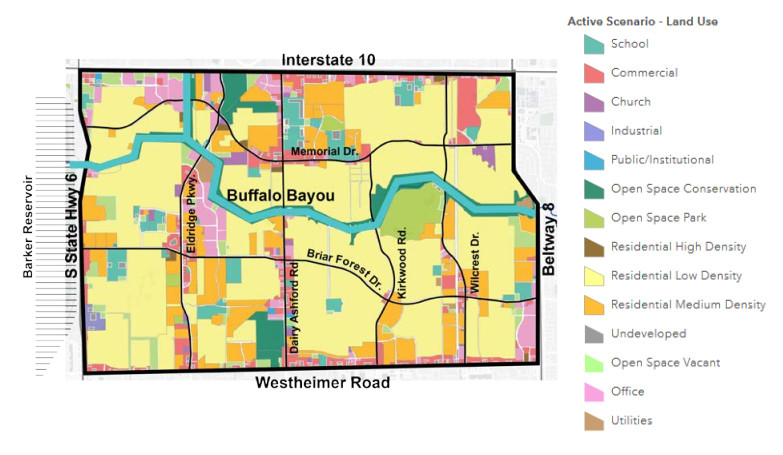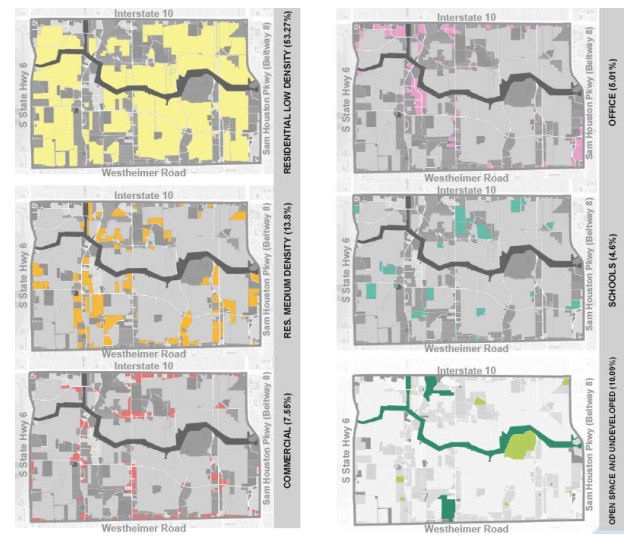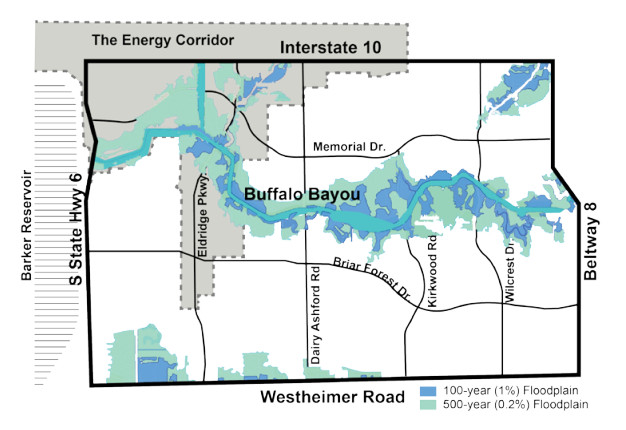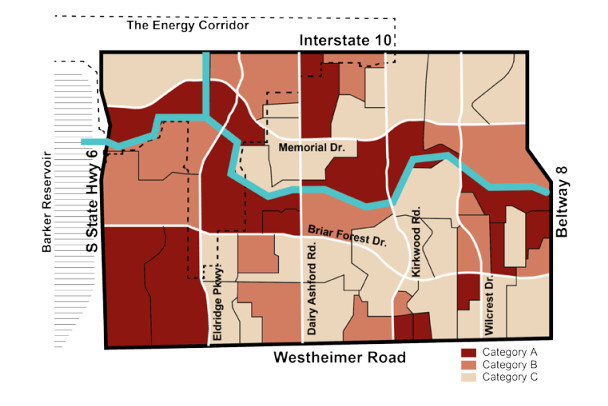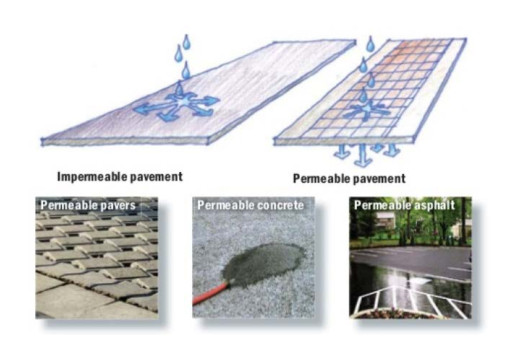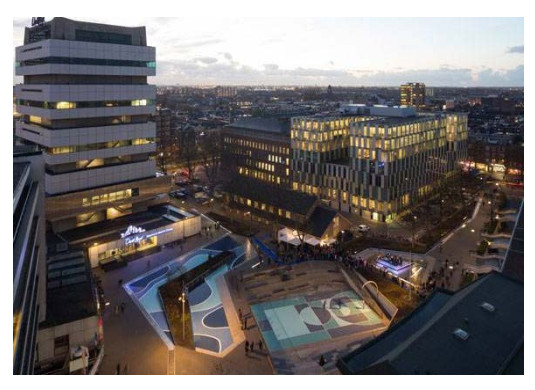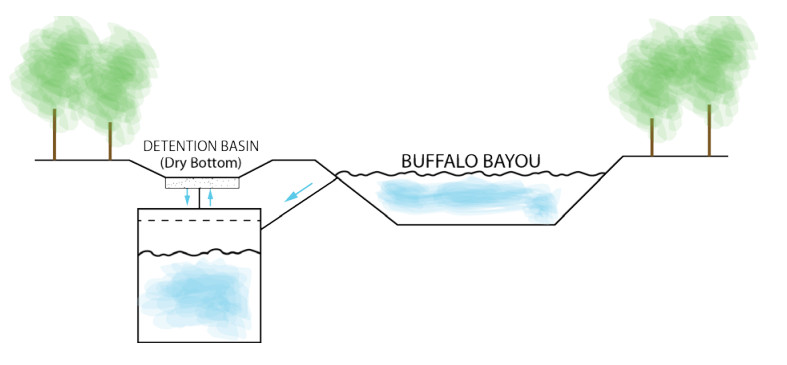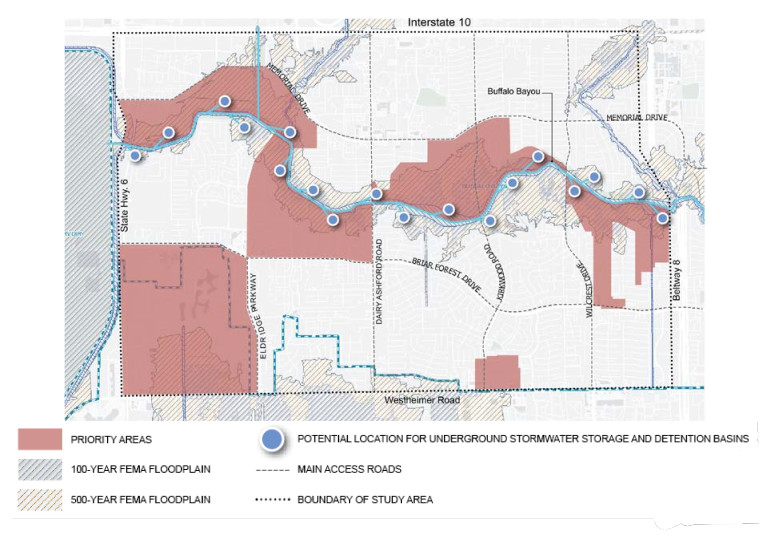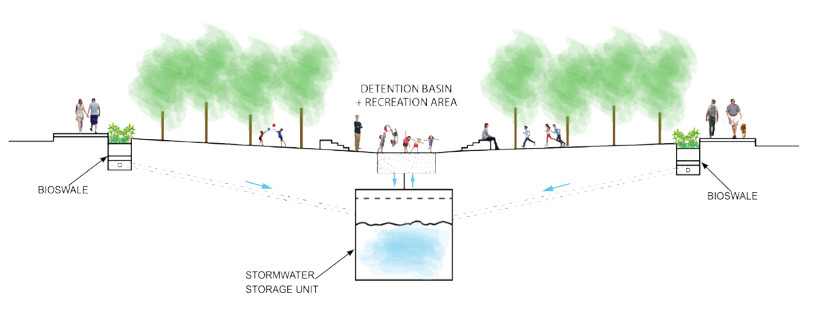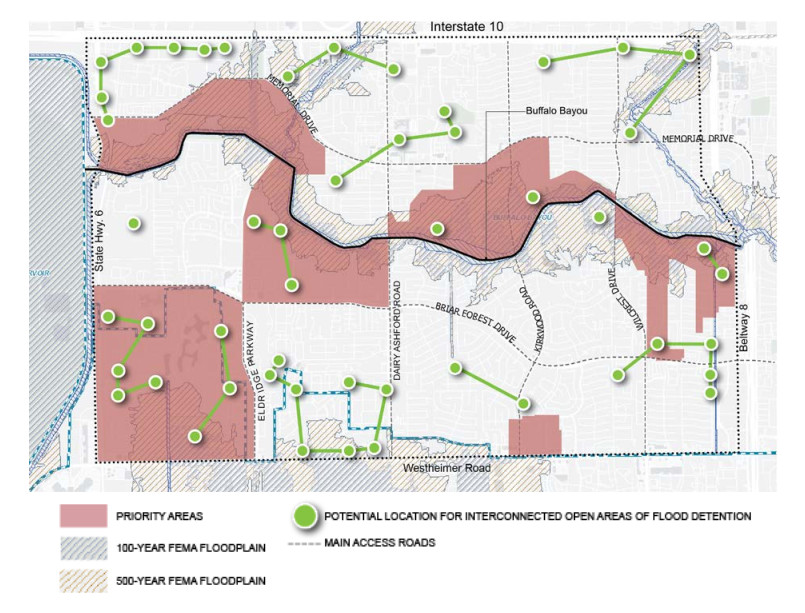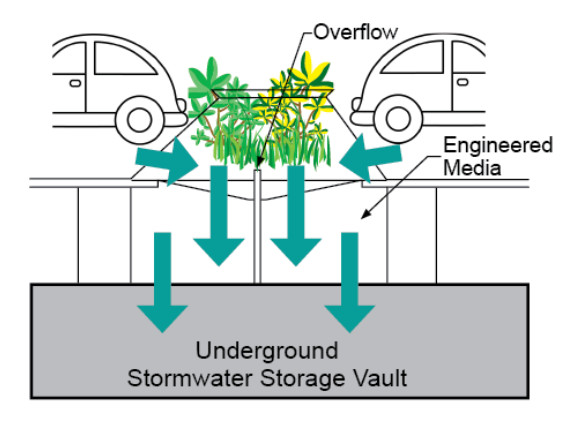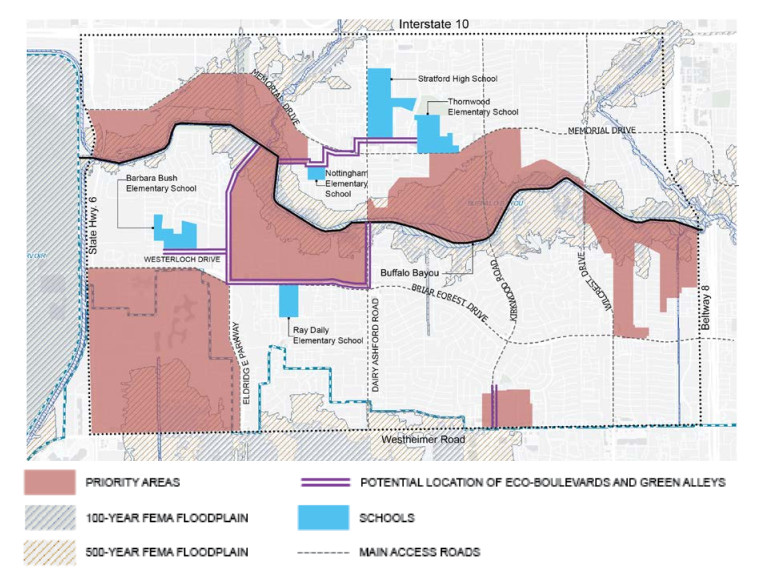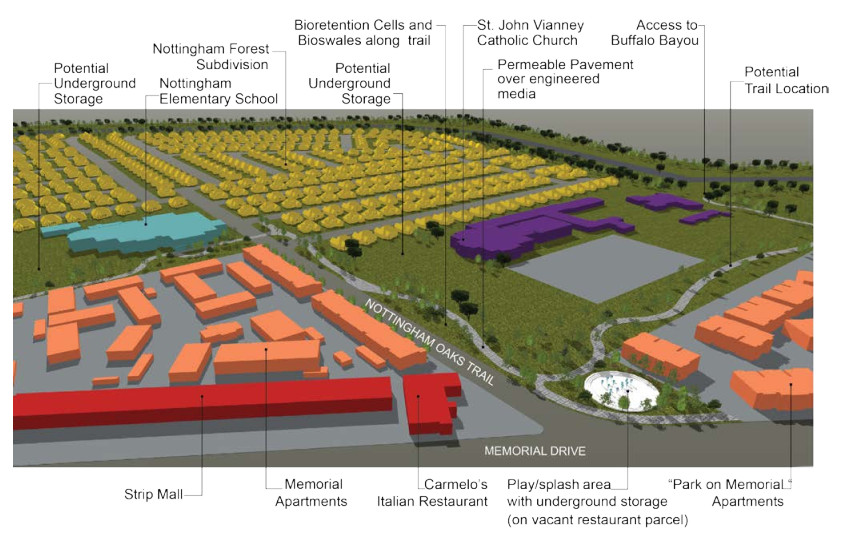The consequences of growing urbanization can be perceived in multiple levels around the globe: overpopulated living conditions, water and air pollution, loss of open space, costly transportation infrastructure, food shortages, fires and floods. The Houston metropolitan area is an example of fast urban growth, with a population increase of more than sixteen percent in seven years, going from 5.8 million people in 2010 to 6.9 million in 2017. By 2045, the robust growth of the region is projected to lead to the addition of approximately five hundred square miles of developed area, including an estimated six million parking spaces, seven hundred eighty million square feet of non-residential uses, and three and a half billion square feet of residential use. The accelerated development, in addition to physical features, geomorphic processes and human activities in the region are believed to have caused Houston to suffer through over fifty devastating floods since its settlement, despite some successful flood damage reduction projects. The present study focused on the potential outcomes of an increased use of green infrastructure in comparable urban areas, and its effects on flooding volume. Results from the research revealed that not only these measures would likely improve the performance of existing urban drainage systems and attenuate flood incidence in the area, but would also promote connectivity between areas otherwise detached or only accessible by car, improving walkability and incentivizing engagement in outdoor activities.
1.
Introduction
The present work is based on scientific literature obtained from Harris County Flood Control District, U.S. Army Corps of Engineers, Greater Houston Flood Mitigation Consortium, Houston-Galveston Area Council, The Kinder Institute for Urban Research, FEMA, EPA and other scientific sources of information associated with the study of flooding, its causes and how it is currently being dealt with in the selected area of study. The invaluable material and data acquired from those sources have provided the foundation for the conception of a methodology capable of expediting the detection of problem areas. Outlining priority areas based on the number of structures damaged by Hurricane Harvey can help detect sources of flooding that could be irradiating the problem to surrounding areas in need of special attention. The study also proposes flood mitigation alternatives that are an amalgamation of methods already in use with new research and experimentations.
Houston is located in Southeast Texas near Galveston Bay and the Gulf of Mexico (Figure 1). It is the seat of Harris County and the principal city of the Houston metropolitan area. The city has a total area of approximately 1556 km2, and Greater Houston has a total area of 26,060 km2, according to the United States Census Bureau [1].
The city of Houston grew around the confluence of White Oak Bayou and Buffalo Bayou, which served as a natural turning basin. The development spread east and west along Buffalo Bayou, spurring at the turn of the century with the construction of the Houston Ship Channel, and continued to grow through the twentieth century with the discovery of petroleum in the region. Oil refineries proliferated along the Ship Channel placing Houston in the center of new oil and oilfield equipment development, and in the 1920s the city saw its first growth spur. In the 1970s, the Arab Oil Embargo caused the demand for Texas oil to escalate, attracting thousands of workers and their families [2]. As it is typical for a growing city, the strongest early growth in Houston was in the core municipality and then gradually shifted to the nearby suburbs. Houston is suburban, and is often characterized as a sprawling urban area, although it has a higher than average urban density if compared to other cities with the same characteristics [3].
While a variety of natural disasters such as tornados, hurricanes, wildfires and drought are quite common in the state of Texas, Houston alone have registered approximately two hundred floods of various intensities since 1837, making them Houston’s major form of natural disaster.
There are a few factors at play. From a spatial perspective, we have most of Houston’s metropolitan area located within a large bioregion of the Texas Gulf Coastal Plain consisting of low elevations and nearly level to gently sloped soils. Downtown Houston stands about fifty feet above sea level and the entire city is relatively flat, with slopes ranging from zero to eight percent throughout the region. Soils are poorly drained to moderately permeable, making storm water drainage especially difficult. From an urban development perspective, we perceive how the vigorous growth experienced by the region in the last decades, associated with the unique ways the city has chosen to approach development regulation may have intensified the flood-prone characteristics of the place.
The connection between the absence of zoning regulations and past flood events has been object of great debate, exacerbated after Hurricane Harvey’s destructive flooding has impacted, directly or indirectly, most residents of Houston in August of 2017. Presumably, flood as result of a storm of that magnitude would have been catastrophic, despite the existence of zoning. Nonetheless, intensive building development has deforested and sealed areas that should otherwise be absorbing stormwater, and caused imbalance and transformation in their natural function as storage and conveyance system for water, nutrients and sediments [4].
Harris County has classified 22 major watersheds that each drain into 22 major waterways. Buffalo Bayou watershed encompasses most of the study area and for this reason is particularly relevant to the research. This watershed is primarily located in west-central Harris County with a small portion crossing into Fort Bend County (Figure 2).
Rainfall within the 264 km2 of the Buffalo Bayou watershed drains to the watershed’s primary waterway, Buffalo Bayou-the longest and largest of the county’s bayous, travelling 85 km before meeting San Jacinto River at Galveston Bay. The Bayou is navigable as far as downtown Houston. Just east of downtown Houston near the Turning Basin, Buffalo Bayou becomes the Houston Ship Channel [5].
Few watersheds have garnered as much attention after Hurricane Harvey as the Addicks, Barker and Buffalo Bayou watersheds. Many neighborhoods upstream of the Addicks and Barker reservoirs flooded, and the releases from the dams placed sections of the area underwater for weeks. In many ways, however, this watershed is a success story. Large reservoirs at the upper end of watersheds can be highly effective, and the 75-year history of Addicks and Barker Reservoirs is an example. Until Hurricane Harvey, few homes flooded in the Buffalo Bayou watershed while neighborhoods along other bayous flooded repeatedly. A gradual reduction in the reservoirs’ capacity (due to silt and vegetation) has reduced their effectiveness, but Buffalo Bayou still has significantly better flood protection than other watersheds [6]. Addicks and Barker reservoirs were built in the 1940s when Congress authorized the United States Army Corps of Engineers (USACE) to construct them as part of the Buffalo Bayou and Tributaries Project (BBTP). The reservoirs are located approximately 27 km from downtown Houston, and were designed to collect excessive amounts of rainfall to be released into Buffalo Bayou at a controlled rate. They fulfill their purpose by impounding water during heavy rainfalls and flood events, but do not store water year-round as it is typical of lake-forming reservoirs. Under normal conditions, both dams have two conduits set to pass the normal flow of water. When the reservoirs are empty and 2.54 cm of rain falls below the dams, the gates are closed until it is safe to make releases. If releases are being made, the gates will be closed if 1.27 cm of rain falls below the reservoirs or flooding is predicted. Normal regulating procedures specify that releases from the two reservoirs, in addition to the uncontrolled runoff downstream, should not exceed 56 m3 per second as measured at the Piney Point Road gauging station. Addicks Dam has a maximum discharge capacity of 222 m3 per second and Barker Dam 247 m3 per second. Attempts to improve drainage and manage stormwater have lead over time to alterations of the flows of nearly all of the Harris County bayous. Buffalo Bayou’s natural functions have been significantly altered by land development in the watershed, the construction of Addicks and Barker reservoirs, and the deepening and widening of the bayou from State Highway 6 to roughly Beltway 8/Rummel Creek. Despite these modifications, Buffalo Bayou is a stressed natural stream in an urban environment [7].
Several projects have been under discussion to determine how to protect Houston from flooding. A third reservoir upstream from the Addicks and Barker Reservoirs in northwest Harris County is one of them. A Coastal Spine Storm Surge Protection System creating a 96.5 km coastal barrier between hurricane storm surge and Galveston Bay is another. On August 14, 2018, Harris County Commissioners Court approved a list of 237 flood risk-reduction projects that would meet the goal of the 2018 bond election. On August 25th, Harris County voters approved two and a half billion dollars in bonds to finance flood damage reduction projects in Harris County, including channel modifications, regional stormwater detention basins, major repairs to flood-damaged drainage structure, voluntary buyouts of flood-prone properties, wetland mitigation and property acquisition for preserving natural floodplains, amongst others. High in the priority list are construction-ready projects with funding partners such as USACE and FEMA. From the 237 projects, 22 are designed for the improvement of the Addicks and Barker Reservoirs, and will be evaluating the reservoirs’ effectiveness and operation, de-silting channels upstream to restore channel conveyance capacity, performing right-of-way acquisitions, constructing wetland mitigation banks and rehabilitating channels inside the reservoirs [8]. Also as part of the 2018 flood bond program, HCFCD (Harris County Flood Control District) was set to receive a federal grant to study the feasibility of constructing deep underground tunnels to move stormwater to the Houston Ship Channel without overburdening the area’s bayous. Engineers envision a system in which tunnels at least 6 meters wide and one 46 meters deep use gravity to move water from upstream bayous to the Ship Channel, in some cases a distance of 48 km. The region’s flatness, soft soil and high water table present a significant obstacle, but similar low-lying cities such as Washington D.C. have been able to use this method of flood control [9].
HCFCD proposed bond projects that include the area of study consist of drainage network repairs, construction of detention basins along Buffalo Bayou, and studies to be performed by USACE, such as the C-40 Study of Addicks and Barker Reservoirs and The Buffalo Bayou and Tributaries Resilience Study, to address flooding downstream and upstream of the reservoirs.
As of September 2019, several Bond Program projects are in progress, many of them in feasibility study phase, such as the large diameter tunnels for stormwater conveyance project, the investigation of multiple stormwater storage areas within the upper Cypress Creek and Addicks Reservoir watersheds and the USACE Section 216 study of Addicks and Barker reservoirs operations and effectiveness. Many other projects, including repairs to channels and other drainage infrastructure damaged during Harvey, subdivision drainage projects, the construction of stormwater detention basins, upgrades and expansion of the Harris County Flood Warning System, Buffalo Bayou biostabilization and a countywide flood hazard assessment with new rainfall data, have either been initiated or have engineering services contracted to perform them.
2.
Materials and methods
Conventional city design has allowed society to thrive and grow in a range of challenging and often uninhabitable environments. However, as global populations increase and shift from rural to urban areas, the scale of urbanized regions is causing a stress surge on the natural environment and its supporting systems. The natural water cycle is disrupted in urban areas because buildings, concrete and other sealed surfaces prevent water from soaking into the ground. As a result, natural water flows are altered, and excess stormwater is created, which is traditionally directed into local waterways via drainage networks. This disruption to the natural water cycle causes many problems, including pollution of waterways, bays and oceans; waterway erosion and degradation; urban flooding; decreased soil moisture and reduced groundwater levels [10].
The core questions this research is proposing to explore include: How can flood volume reduction be achieved in the selected and similar areas? Would integration of green infrastructure with existing flood control management and water resources significantly mitigate the flooding problem? How can the existing built environment be reconciled with its surroundings to create a cohesive landscape? The questions at issue were comprehensively examined with the use of Geodesign processes, which allow for the integration of sustainable landscape design with multiple supporting disciplines and new-generation spatial information/digital technologies [11].
2.1. The proposed approach is subdivided into five phases
2.1.1. Defining a Pilot Study Area
A section of the Buffalo Bayou watershed containing 57 Census Block Groups and a surface area of approximately 43.7 km2 was outlined as a “pilot study area” for the design model being proposed. An initial approach considered the area adequate due to its proximity to Addicks and Barker reservoirs, Terry Hershey Park, Buffalo Bayou and to the Energy Corridor, the second-largest employment center in the region [12]. Most importantly, the selected area was one of the most impacted during Hurricane Harvey. The underlying idea was to create a “prototype” based on one of the most challenging sections of the study area that could be replicated, with the appropriate adjustments, in comparable areas throughout the region.
The pilot study area (Figures 3 and 4) is highly developed-approximately 90%-and densely populated, and is a blend of residential land uses, intermixed with office, commercial, public/institutional and industrial development, as Houston does not mandate the separation of different land use categories. The majority of commercial and office structures is distributed along Eldridge Parkway, Dairy Ashford Road, Memorial Drive and Interstate 10. The area has eleven elementary schools, two middle schools, three high schools and ten private schools. Most of the undeveloped land is composed of parks and open space for a total of 4.12 km2, 0.84 km2 of which belong to Lakeside Country Club, a private golf course, and approximately 2.02 km2 to Terry Hershey Park, a public pedestrian-friendly greenbelt. Buffalo Bayou crosses the entire study area from west to east, and Terry Hershey Park runs along the Bayou for approximately 9.6 km. Current land use types and their percentages within the pilot study area are represented on Figure 5.
According to the Houston-Galveston 2018 Regional Demographic Report, the study area has approximately 45,016 households and 50,366 housing units, with a population of 106,305 residents.
High urbanization and concrete coverage, and extreme occupation of the 100-year and 500-year floodplains are characteristics of this area, which had one of the highest estimated number of affected units in the region during Hurricane Harvey-approximately 19,843-according to FEMA data from December 2017, and one of the highest number of applications for individual assistance[13].
The combined 1% (100-year) and 0.2% (500-year) floodplains (Figure 6) cover an estimated area of 9.79 km2 within the study area, approximately 22 percent. HCFCD estimates there are 184,546 structures inside the 1% (100-year) FEMA floodplain and 230,838 structures inside the 0.2% (500-year) FEMA floodplain within Harris County’s 22 watersheds, as of June 2018 [14].
2.1.2. Identifying Priority Areas within the pilot
Based upon FEMA data post-Harvey, the pilot study area was then subdivided into three categories A, B and C. These categories represent the number of structures damaged during the hurricane for each of the 57 Census Block Groups (CBG), and will assist on identifying particularly sensitive areas that should be prioritized. Category A includes areas with a number of damaged structures between 500 and 1600 per CBG. Category B, between 300 and 499 per CBG. Category C, between 1 and 299 per CBG. Table 1 and Figure 7 show the results of this method.
Category A areas shown on Figure 7 had the highest number of damaged structures per km2 and became the focal point of the pilot study area. Most of these areas are located along the 10.3 linear kilometers of Buffalo Bayou between State Highway 6 and Beltway 8, and the remaining areas flooded as result of an overwhelmed drainage network.
2.1.3. Exploring flood volume reduction options
Low Impact Development (LID), Sponge Cities, Eco-Boulevards, Water Squares and Green Alleys were concepts taken into consideration.
LID is a comprehensive land planning and engineering design approach with the goal of maintaining the pre-development hydrologic regime in a watershed without solely using conventional development and detention basin techniques to satisfy drainage and flood mitigation requirements. Acceptable LID practices include bioretention, rainwater harvesting, green roofs, permeable pavement and underground stormwater storage, among others [15].
The Sponge City concept was launched by the Chinese Central Government in selected pilot cities across China in 2014, primarily as a response to increasing flood impacts. The Sponge City approach aims to enhance infiltration, evapotranspiration, and capture and reuse of stormwater in the urban environment. Some of the anticipated benefits of this concept are the reduction of economic losses due to flooding and enhancement of the livability of cities [16].
The Eco-Boulevard concept is presented in various forms. One architecture firm in Chicago, Urban Lab, has partnered with the City of Chicago to cultivate the Eco-Boulevard project and transform streets into eco-boulevards that could treat the city’s wastewater and stormwater naturally. Their approach is to transform existing roadways, sidewalks and parks (the public-way) into a holistic, distributed, passive bio-system for recycling Chicago’s water and return all treated water to the Great Lakes, closing Chicago’s water loop [17]. Since 2006, more than one hundred Green Alleys and Eco-Boulevards have been built in Chicago as stretches of permeable pavement (Figure 8) and bioswales that allow storm waters to filter through and drain into the ground below, where microbes remove bacteria and pollutants before the water is allowed to run into nearby Lake Michigan. “The Green Alleys create porosity and permeability so that the water can move in the ways that it moves in the hydrological cycle”, according to Jay Homack, a senior landscape architect who designed most of the infrastructure [18].
Water Squares combine water storage with the improvement of the quality of urban public space. They are generally used in inner-city areas with little room for water buffers and where high groundwater levels make infiltration difficult. Water Squares can be understood as a dual-strategy that makes the money invested in water storage facilities visible and enjoyable. They also generate opportunities to create environmental quality and identity to central spaces in neighborhoods, as most of the time a water square will be dry and used as a recreational space. A great example is the Waterplein Benthemplein, in Rotterdam, Netherlands, a square that features three concrete basins of different depth that are used for leisure activities in dry weather (Figure 9). During heavy rainfalls those basins are temporarily submerged in order to relieve Rotterdam’s sewage system. The waters of the surrounding surfaces and rooftops are collected in the basins forming three small lakes in the middle of the square [19].
2.1.4. Calculating detention volume for a 1% probability, 24-hour storm
The HCFCD 2009 Hydrology and Hydraulics Guidance Manual [20], defines impervious cover as the amount of the drainage area in which water cannot infiltrate into the soil because of impenetrable surfaces. The extent of impervious cover influences the amount of runoff. Percentage of impervious cover is a measure of development, and the generalized relationship between percent land development and percent impervious cover is summarized below:
● Undeveloped (unimproved, natural or agricultural) = 0% development/0% impervious
● Residential, small lot (≥ 1000 m2) = 100% development/40% impervious
● Residential, large lot (>1000 m2) = 50% development/20% impervious
● Schools (with non-paved areas) = 50% development/40% impervious
● High Density (commercial, business, industrial, apartments) = 100% development/85% impervious
● Water (detention basins, lakes and channels) = 100% development/100% impervious
The Watershed Modeling method involves use of the HCFCD hydrologic methodology developed to identify flood damage reduction and mitigation projects for drainage areas greater than 2.58 km2 in Harris County. Depths of direct runoff for the 24-hour, 1% probability rainfall event selected for this model are provided in the HCFCD Policy Criteria and Procedure Manual (PCPM) for each rainfall region [21]. Buffalo Bayou is classified as Region 2 and estimated direct runoff values for three impervious conditions are shown on Table 2.
The approximate area of impervious surface within the pilot study area was calculated by multiplying the Percent Impervious Cover Per Land Use values from the HCFCD Policy Criteria and Procedure Manual by the total area of each land use type obtained in Geoplanner for ArcGIS (Table 3).
Based on this information, the total detention volume needed for a 100-year, 24-hour storm event in the pilot study area should be 5,392,320 m3, as shown on Table 4 (impervious area 16,440,000 m2
× direct runoff 0.328 m).
2.1.5. Detecting potential sites for the implementation of flood mitigation strategies
In order to have quantitative evidence of the pilot area’s capability to accommodate the elected strategies, the Land Use map generated in Geoplanner for ArcGIS software-with land use data from the City of Houston GIS portal (Figure 4)-was examined, and vacant and undeveloped sites were outlined for each parcel of land within the pilot area. The objective was to obtain a total area of potential stormwater detention/storage sites, publicly or privately owned, per land use type.
3.
Results
Assuming the area’s existing drainage system is adequate and provides the detention volume required for a 100-year, 24-hour storm event-as specified in the HCFCD-PCPM-this study aimed to identify opportunities to reduce riverine flooding along Buffalo Bayou as well as to identify potential locations for mitigation of secondary local drainage, during unforeseen storm events. Embedded in this purpose is the development of urban design concepts that propose to enhance quality of life of area residents while reducing flood threat.
3.1. Proposed flood mitigation strategies
In April 2018, FEMA amended the longstanding 100-year floodplain standard for new projects such that most new buildings will now have to be two feet freeboard. Freeboard is a factor usually expressed in centimeters above a flood level for purposes of building above a floodplain. Today, building codes in many jurisdictions require construction to be 30.48 cm freeboard. The City Public Works Department produced an analysis showing that the projected water level in a 500-year floodplain plus a 61 cm elevation would have spared 84% of homes in city floodplains during Hurricane Harvey [22]. Considering these results, the stormwater detention volume was recalculated to reflect a runoff depth of 61 cm (Table 5).
Subtracting 5,392,320 m3 of provided detention volume from the 10,028,400 m3 new required detention volume, the goal is to provide the remaining 4,635,418 m3 of stormwater detention possibilities.
3.1.1. Along Buffalo Bayou
Allocation of stormwater storage cisterns in the 1.13 km2 of public land along Buffalo Bayou. These are underground units to be positioned along Buffalo Bayou at intervals to be determined contingent to technical feasibility. Each unit is to be connect to the bayou through an inlet-outlet pipe at an angle to be determined (Figure 10).
During a storm event, if the Bayou reaches a critical level, the water pressure will cause the connection to the unit to open, redirecting part of the flow of water from the bayou into that unit. Once the unit is full, the water pressure inside the unit will cause the connection to the bayou to shut. These units will be also collecting rain from detention basins located above them, and a layer of engineered soil between the basin and the unit will promote the filtration of the water before it enters the unit. Eighteen cisterns along Buffalo Bayou’s 10.3 linear kilometers between State Highway 6 and Beltway 8 (Figure 11), each with an approximate capacity of 63,709 m3, would provide 1,146,762 m3 of stormwater detention volume in the pilot study area.
3.1.2. Beyond Buffalo Bayou
Approximately 0.83 km2* of private and public vacant land were identified with Geoplanner for ArcGIS as potential stormwater detention development areas (Table 6). Those sites consist of vacant lots and segments of undeveloped land from school, commercial, office, church, industrial and residential uses. Many of those areas have the potential to being converted into flood mitigation sites through the implementation of localized storm drainage enhancements, such as the use of LID methods and, when feasible, the incorporation of underground stormwater storage units. Contingent upon neighboring land uses, community enhancements like parks, splash pads, sport courts or water squares/circles could also be incorporated (Figure 12).
* 0.83 km2 = 1.96 km2 total potential stormwater retention sites minus 1.13 km2 of public land along Buffalo Bayou.
An initial approach identified 50 possible sites where underground stormwater storage units could be implemented (Figure 13). That number of units would provide 3,184,845 m3 of detention volume.
3.1.3. Underground stormwater detention vaults
Approximately 0.47 km2 of parking lot area were identified with Geoplanner for ArcGIS as potentially suitable sites for the construction of underground storage vaults within the study area. These stormwater detention vaults are underground structures designed to manage excess stormwater runoff on a developed site. Stormwater enters the system through a riser pipe connected to a catch basin or curb inlet and flows into a series of chambers or compartments for storage (Figure 14). Subsurface stormwater storage provides minimal stormwater quality benefit, but can be successfully used for reduction of stormwater runoff flow. It is a good option for high density or urban areas with limited permeable area. From the initial 4,635,418 m3 of detention volume needed, 4,331,982 m3 can potentially be reached through the implementation of underground stormwater storage units along Buffalo Bayou and at the undeveloped sites shown on Figure 13. The remaining 302,203 m3 of detention volume can be obtained with the construction of underground storage vaults throughout the area.
3.1.4. Eco-boulevards and green alleys
The map on Figure 15 depicts the location of five schools within the study area, and the potential pathways of eco-boulevards and green alleys linking them and the neighborhoods to which they belong. This study identified approximately 8 km of potential green alleys/eco-boulevards, with the capability of connecting neighborhoods to infrastructure services, parks, and to Buffalo Bayou trails. In order for people to truly experience and benefit from walking in a walkable environment, starting points and target destinations need to be continuously connected to promote a comfortable and safe walk to their destination without having to share the road with motor vehicles at any given point. Therefore, both walkability and connectivity need to be addressed simultaneously [23].
Represented on Figure 16 is a conceptual design of a green alley connecting Nottingham Elementary School to Buffalo Bayou and Dairy Ashford. The school is encroached on a highly populated area and surrounded by Nottingham Forest-an eight-hundred home subdivision-two apartment complexes, a church, retail and restaurants. The total distance from the school to Buffalo Bayou is 0.9 km of curvy vegetated trails of permeable pavers with bioswales and bioretention cells alongside them. These LID features are connected to one or more underground stormwater storage units. One of these units is installed underneath the 3165 m2 lot/vacant restaurant for sale at the corner of Memorial Drive and Nottingham Oaks Trail, converted into a splash park/water circle over that unit. In addition to improving stormwater drainage in areas very susceptible to flooding, eco-boulevards can provide multiple ecological and social benefits, promoting connectivity and a healthy quality of life.
4.
Conclusion
This study has provided insights into conventional and new methods of flood prevention that can be applied in areas characterized by low elevations, poorly drained and nearly leveled soil surfaces, high urbanization rate and susceptibility to hurricane damage.
An examination of the possible mitigation measures focused on methods that could provide the desired results of flood volume reduction while achieving environmental, social, and economic benefits. Research included processes used in the U.S and abroad, such as LID, the water squares of the Netherlands and China’s sponge cities.
The research also reveals that the flood-risk reduction projects approved as part of the Bond Program voted in 2018 in Harris County are moving forward. New countywide flood hazard assessment with new rainfall data, as well as many other projects found in the program will be valuable and are long overdue, but at this point the introduction of green infrastructure suggested in this study was not identified as part of the existing projects.
The findings of this study suggest that 4,635,418 m3 of stormwater detention volume are required in order to provide flood protection to the 43.74 km2 study area, during a model 24-hour, 1% probability storm with a total rainfall amount of 62.23 cm. The proposed underground storage units can potentially provide the total detention volume and be incorporated to most priority areas. The underground storage vaults in parking lots, and the LID tools integrated to the urbanized areas in form of green alleys and eco-boulevards would work in parallel to ensure absorbency to other impervious areas.
Results imply that the reclamation of stormwater-a natural asset too important to be discarded-can be achieved with the use of underground storage. The sustainabilization of urbanized areas is also attainable, via the integration of LID methods, and the enhancement of community areas can promote a healthier lifestyle, with the implementation of green alleys, water squares and eco-boulevards. Moreover, the combination of these procedures could reduce considerably the flood volume in the area.
Approximately 8 km of potential Green Alleys and Eco-Boulevards were identified in the pilot study area, with the capability of connecting neighborhoods and schools to infrastructure services, parks and to Buffalo Bayou trails. In addition to the social and economic benefits discussed, the use of LID practices such as bioswales and permeable pavements in the concept would substantially improve the areas’ resilience to flooding.
Therefore, developing sustainable, attractive, walkable and safe built environments, and incorporating flood mitigation strategies into the concept of green infrastructure is a possibility substantiated in this study. Disasters are characterized by naturally occurring events with consequences often agammaavated by the cumulative effects of decisions previously taken in terms of land management, including unregulated growth of urban areas [24]. Whether or not the suggestions made in the present study can become an effective approach toward a future with less flood damage will depend on multiple socio-economic externalities for the regions where they are implemented.
Acknowledgments
The author would like to thank Professors Jim Sipes and Kelleann Foster, from the Penn State Geodesign Graduate Program, for their invaluable direction and advice in undertaking this study. Gratitude also goes to Houston residents who, through their testimony and insight, helped delineate this report. And to HGAC, HCFDC, The Greater Houston Flood Mitigation Consortium and the Kinder Institute for Urban Research for providing instrumental data and feedback, without which this report would not have been possible.
Conflicts of interest
The authors declare no conflict of interest.
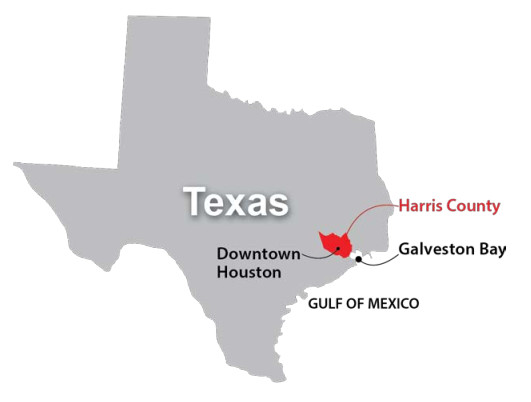









 DownLoad:
DownLoad:
